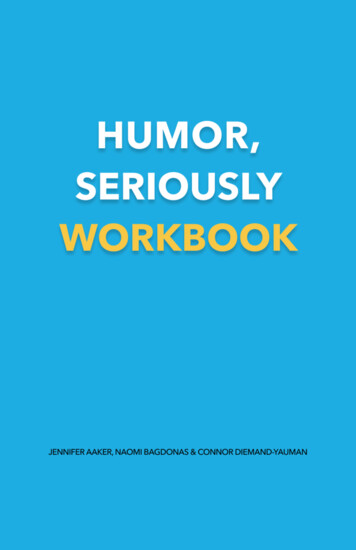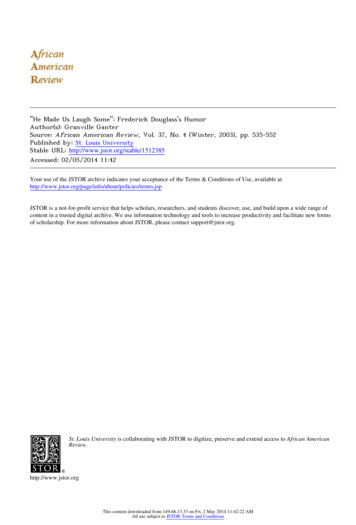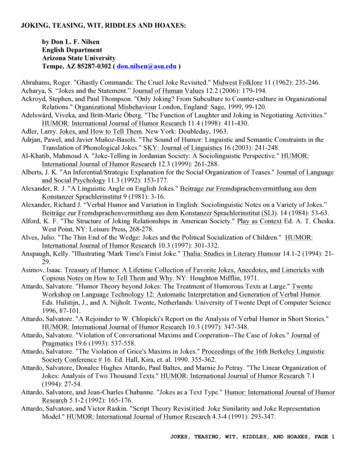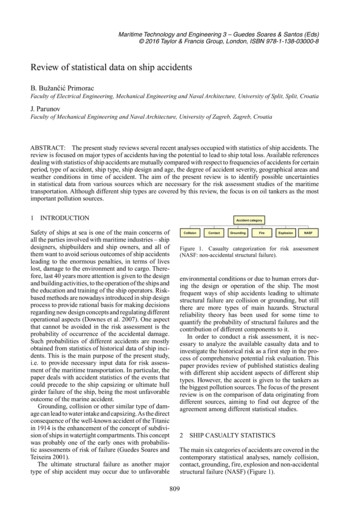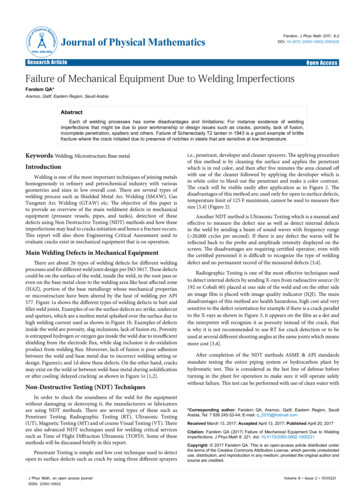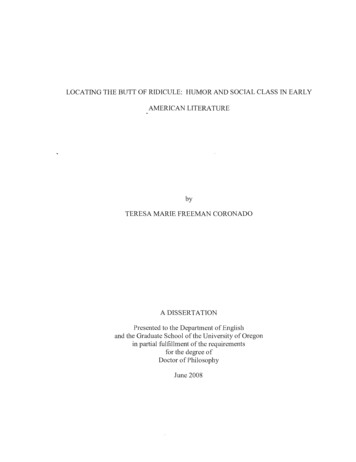
Transcription
LOCATING THE BUTT OF RIDICULE: HUMOR AND SOCIAL CLASS IN EARLYAMERICAN LITERATUREbyTERESA MARIE FREEMAN CORONADOA DISSERTATIONPresented to the Department of Englishand the Graduate School of the University of Oregonin partial fulfillment of the requirementsfor the degree ofDoctor of PhilosophyJune 2008
11University of Oregon Graduate SchoolConfirmation of Approval and Acceptance of Dissertation prepared by:Teresa CoronadoTitle:"Locating the Butt of Ridicule: Humor and Social Class in Early American Literature"This dissertation has been accepted and approved in partial fulfillment of therequirements for the Doctor of Philosophy degree in the Department of English by:Gordon Sayre, Chairperson, EnglishMary Wood, Member, EnglishHenry Wonham, Member, EnglishMatthew Dennis, Outside Member, Historyand Richard Linton, Vice President for Research and Graduate Studies/Dean of theGraduate School for the University of Oregon.June 14,2008Original approval signatures are on file with the Graduate School and the University ofOregon Libraries.
111 2008 Teresa Marie Freeman Coronado
IVAn Abstract of the Dissertation offor the degree ofTeresa Marie Freeman Coronadoin the Department of EnglishDoctor of PhilosophyJune 2008to be takenTitle: LOCATING THE BUTT OF RIDICULE: HUMOR AND SOCIAL CLASS INEARLY AMERICAN LITERATUREApproved:Dr. Gordon SayreThis project critiques the performance of class identity through the works ofeighteenth- and nineteenth-century colonial and early national period authors using thelens of humor, primarily as posed by Elliot Gring and Henri Bergson's theories oflaughter and the ridiculous. My argument is that under the guise oflaughter these worksconceal the underpinnings of an American class system which can be revealed throughclose reading and historical research.In my dissertation, I examine the performance of each author in his or her ownautobiography and the reflection of that performance within the larger frame of thedevelopment of American status structures. The characters in the texts of the authors Iwork with in this project demonstrate the use ofthe comic persona to, as scholar RobertMicklus states, "locate the butt of ridicule anywhere but in their own mirrors"; however,in my project I examine this within the context of class. Chapter I examines the work of
vMadame Sarah Knight, The Journal ofMadame Knight, and William Byrd II's TheSecret History ofthe Line-both of whom use humor to disguise their class insecurities.In Chapter II, I examine the performance of class hierarchy, as seen through Franklin'sAutobiography and John Robert Shaw's John Robert Shaw: An Autobiography ofThirtyYears, 1777-1807. In Chapter III, I examine the complications of race involved in classrelations, using John Marrant's autobiography, A Narrative ofthe Life ofJohn Marrant, aFree Black. Chapter IV examines David Crockett's humorous performance ofthe middlelandscape frontiersman as part of a valorized national identity in The Narrative ofDavidCrockett.The ideology that prompts the so-called invisibility of class in United Statessociety today requires us to examine it under a critical lens; this project uses humor asthat lens. In questioning the laughter of early American texts, we can see the classdivides of early American society being created-an important step to realizing howthese divides are maintained in our world today.
VICURRICULUM VITAENAME OF AUTHOR: Teresa Marie Freeman CoronadoPLACE OF BIRTH: Augusta, GeorgiaDATE OF BIRTH: June 30,1975GRADUATE AND UNDERGRADUATE SCHOOLS ATTENDED:University of Oregon, Eugene, OregonEastern New Mexico University, Portales, New MexicoHillsdale College, Hillsdale, MichiganDEGREES AWARDED:Doctor of Philosophy in English, 2008, University of OregonMaster of Arts in English, 2003, Eastern New Mexico UniversityBachelor of Arts in English, 1996, Hillsdale CollegeAREAS OF SPECIAL INTEREST:Colonial American LiteratureNineteenth-century American LiteratureHumor StudiesClass, Race, and Gender StudiesPROFESSIONAL EXPERIENCE:Graduate Teaching Fellow, English. 2003-2008.GRANTS, AWARDS AND HONORS:Kappa Kappa Gamma Foundation Fellowship, Kappa Kappa Gamma NationalFraternity, 2006-2007Graduate Research Award, English Department, University of Oregon, 2004-2005
VllPUBLICATIONS:Coronado, Teresa. "Social Immobility: Franklin's Autobiography and ClassBased Humor." Online posting. October 15, 2007. Eighteenth-CenturyStudent Reading Group (ASECS). http://www.asecsgrad.blogspoLcom/ .Coronado, Teresa. Rev. of Mindfit! Conservatism by Chet Bowers. CapitalismNature Socialism 17.3 (September 2006): 124-25.
V111ACKNOWLEDGMENTSI wish to express sincere appreciation to Professor Gordon Sayre for his help andsupport in the long process of the creation of this project. I would also like to thank mycommittee, Professor Mary Wood, Professor Harry Wonham, and Professor MatthewDennis, for their presence during the writing and defending process. As well, I wouldlike to thank the professors at Eastern New Mexico University who helped me throughthe first few years of graduate school-help that brought me to the University of Oregonand this dissertation subject. The Kappa Kappa Gamma Foundation offered me afellowship when it was very much needed and I thankfully acknowledge their financialsupport. My parents, Nancy and Santiago Coronado, offered love, help, and support inunquantifiable ways and I humbly thank them for their presence in my life.
IXTo My Family-Past and Present
xTABLE OF CONTENTSChapterI. INTRODUCTIONPage.II. ATTENTION TO PRETENSION: TRAVEL NARRATIVES ANDSOCIETAL LADDERS15III. NOBODY'S FOOL: JOHN MARRANT, THE TRICKSTER TRADITION,AND SPIRITUAL AUTOBIOGRAPHY67IV. APPEARENCES AREN'T EVERYTHTI\JG-THEY ARE THE ONLYTHING: BENJAMIN FRANKIN, JOHN ROBERT SHAW, AND THEPERFORMANCE OF CLASS100V. EXPLOITING THE FRONTIER: THE PERFORMANCE OF CLASS INDAVY CROCKETT'S A NARRATIVE OF THE LIFE OF DAVID CROCKETTOF THE STATE OF TENNESSEE144BIBLIOGRAPHY.187
1CHAPTER IINTRODUCTIONNil habet infelix paupertas durius in se,Quam quod ridiculos hominus facit.Or;Unfortunate poverty has in itself nothing harder to bearthan that it makes men ridiculous.-Juvenal, Satires 3.52-53 (qtd. in Sidney 952)The idea of humor is universal--what is different across time, culture,generations, class, and individuals is what humor is. In this project, I examine instancesof humor in early American autobiography that reflect the tastes and ideals of individualswho are also making statements about class through their particular use of humor. Theselife-writing texts reveal the performance of class displayed in the use of humor. Theauthors I will examine include Madame Sarah Kemble Knight, William Byrd II, JohnMarrant, John Robert Shaw, Benjamin Franklin and David Crockett, as well ascomp3rator texts, such as tIle legends of Mike Fink and the memoir of StephanBurroughs. In each chapter, I discuss the particular types of humor each author employs,as well as the performance involved in "playing" class. This project plans to critique theperformance of class identity through the works of 18 th and 19th century colonial andearly national period authors. In this dissertation I am aiming to examine· how the use of
2the comic persona works within these texts to perform an act of class or classlessnessand hides that performance behind a comic mask.In one apocryphal scene in Mark Twain's Roughing It, Twain describes a momentin his journey when he has to lessen his baggage load in order to take the stagecoach toCarson City, Nevada. Twain and his brother leave the stovepipe hats and patent-leatherboots, but made sure to hang on to "six pounds of unabridged dictionary" (31). Theretention of this dictionary is one ofthe props of civilization that, unlike clothes, Twainand his brother do not feel they can leave behind in their sojourn into the wilds ofNevada. They require a marker of civilization to help them perform their culturalbackground. In this case, that outside prop is the dictionary. As their coach approachesrougher country, it is this prop that begins to fly about the coach wildly: "Every time weavalanched from one end of the stage to the other, the unabridged dictionary would cometoo; and every time it came down it damaged somebody" (42). This dictionary, whichTwain remarks "could be bought in San Francisco one day and received in Carson Citythe next" (31 )-and was therefore not a necessary part of their luggage-is pari ofperforming civilization that Twain humorously critiques throughout Roughing It. Thedictionary is a physical, painful e\'en, reminder oftlle props of ci\'ilization required ofthem (or that they require of themselves) to maintain their class identity.Twain's humor in this scene is the perfect delivery system for ajab at suchclassist idealism. This scene of disarray and the dangerous flying dictionary comes from alegacy of humor that is an integral pari of class perforn1ance in American literary history.In Roughing It, Twain brings together humor and class understanding that I identify as
3coming from a line of similar understandings in early American literature. Obviously,the traditions of sarcasm, wit, humor, laughter, parody, et cetera, are a part of a longerliterary tradition. In my project, however, I examine the integration of these types ofhumor] in the American social class system through the class performances of authors intheir literary ventures.In The Archive and the Repertoire: Pel:forming Cultural Memory in theAmericas, Diana Taylor argues that "Cultural identity is highly performative.Recognition is predicated on embodied behaviors and speech acts: the languages wespeak, the way we 'do' our gender and sexuality, the ways in which class and race areunderstandable and made visible, the degree of agency displayed by social actors" (121).Class, in my project, is made visible through markers beyond clothing and one'smonetary status. Thorstein Veblen's The Theory ofthe Leisure Class is one of theseminal texts on American cultural mores in the nineteenth and twentieth century.Veblen writes, "Manners, we are told, are in part an elaboration of gesture, and in partthey are symbolical and conventionalized survivals representing former acts ofdominance or of personal service or of personal contact. In a large part they are anexpression of the relation of status" (35). The acts of class performed in the texts in eachchapter of this dissertation are performed through recognition of social norms and thepretense of "forgetting the acquisition" (Bourdieu 3) of culture, all the whilereconstructing a class hierarchy with clear demarcations of who is in and who is out.The myth of a classless nation still exists, despite all arguments to the contrary,and the perfonnance of class is rarely subject to critique. Diana Taylor reminds us that
4"Performances function as vital acts of transfer, transmitting social knowledge, memory,and a sense of identity through reiterated [behaviorJ" (2). The acts of mimicry performedby comic personae in early American texts are, thus, vital to the cultural memory of classcreation and, in some cases, its undermining. In each instance, the efforts behind classconstruction and reproduction, especially social class as opposed to a strict monetaryhierarchy, becomes more clearly a part of the culture of the United States of America.Through the examination of humor, I propose to add to what critiques of classperformance does exist.My idea of class performance is also based upon Judith Butler's argumentsregarding sexuality and perfonnance. While Taylor focuses on the idea of performancein general as part of cultural identity, Butler's arguments in regards to "replication" and"resignification" offer nuances to Taylor's contention that I find necessary to my ownarguments about class perfonnance. In "Imitation and Gender Insubordination," JudithButler argues, "gender is a kind of imitation for which there is no original" (722).FUliher, that "the parodic replication and resignification of heterosexual constructs withinnon-heterosexual frames brings into relief the utterly constructed status of the so-calledoriginal, but itS110WSthat heterosexuality only constitutes itself as the original through aconvincing act of repetition" (724). In the same way, there is no original class structure.This so-called structure is a continuum of encounters in which differences can beexploited to create a (fictional) class structure. Thus, those who wish to be consideredwithin a certain sphere of influence create a set of rules that must necessarily repeat itself
5in order to be convincing and hegemonic. The "original" in this case can only constituteitself in contrast to what is "other."Pierre Bourdieu and Norbert Elias offer sociological research in the amorphousfield of social class and mannerisms and both offer time as a strong component behindthe acquisition of both: "Legitimate manners owe their value to the fact that theymanifest the rarest conditions of acquisition, that is, a social power over time which istacitly recognized as the supreme excellence [. J and applied by those who can taketheir time" (Bourdieu 71-72). It is the acquisition of mannerisms over the course oftime,the transference of the performance of class over time, which marks the "legitimate" fromthe nouveau of each class congregation. Thorstein Veblen writes that "Refined tastes,manners, and habits of life are a useful evidence of gentility, because good breedingrequires time, applications, and expense, and can therefore not be compassed by thosewhose time and energy are taken up with work" (36). In my project I focus mainly on theconstruction ofthe ideals ofthe middling classes, from the aping ofthe aristocratsmocked by William Byrd II to the snobbery of the frontiersman as not being one of thearistocracy, and the growing ideals of the people who lived in the social status betweenaristocrat and out-and-out poor in a country attempting to construct its own nationalidentity and mores.The subject of American class2 , especially in pre-industrial times, requires anunderstanding of the systems of class that were working in pre-Revolutionary America.Richard Slotkin offers one view:Although there were class divisions sharply drawn in all the colonies, and classantagonisms in each, the points of contention between classes-and the nature,
6numbers, and proportionate strength of the classes-did not correspond to Englishnorms. Distinctions were drawn between 'commonality' and 'men of note' but'middling' men were more numerous proportionately in New England than in old,and there was no landed aristocracy to check the rise of tradesmen and artisans tothe highest social rank. [.] The English vocabulary of social values anddistinctions was thus to a large extent inapplicable to the American situation.(Regeneration Through Violence 68)Jennifer Goloboy adds to that reading in "The Early American Middle Class": "Thenature of the middle class was based not on its material situation [in the eighteenthcentury], but on the set of values that gave it its sense of pride" (545). Each author in mydissertation finds him or her self in a place of confusion with what the set of values arethat give his or her class "its sense of pride" and with how to define him or her self with,or against, this particular set of values.Class is a difficult subject to tackle for many reasons-in this work the difficultylies in the attempt at defining the middle class in a pre-industrial time. The vaguest, yetmost apt, definition comes from Bourdieu: "a class or class fraction is identified not onlyby its position in the relation of production, as identified through indices such asoccupation, income or even educational level, [.but] by a whole set of subsidiarycharacteristics which may function, in the form of tacit requirements, as real principles ofselection or exclusion witllout eyer being fOlllla]]y stated" (102). It is the "tacitrequirements" in the writings ofthe authors upon which I focus in my dissertation.I would like to note that my discussions of class may seem anachronistic, butthese texts a]] spring from the European settling of the Americas, an imperialist act thatforeshadows a more fonnal market capitalism that Marx tackles after the IndustrialRevolution 3 . My discussions of class respond to theories of social class, such as that in
7Pierre Bourdieu's Distinctions, rather than a strict monetary capitalism, like Marx. Thus,my use of the word may be pushing historical limits, but, even in The Journal ofMadameKnight, written in 1704, I am justified in using class in both its social and economicsenses.My interest in the particular intersections of class and humor was first piquedwhile reading Robert Micklus' article "Colonial Humor: Beginning with the Butt," whichalso investigates comic personae in a few early American texts; however, I have departedfrom his ideas and arguments in that while he focuses on asking, generally, "what did ourearliest humorists, north and south, laugh at?" (140), I ask why. Micklus touches uponclass and manner differences as a reason for some authors to laugh at others, includingMadame Knight and William Byrd II, but I delve deeper into the reasons why theseauthors created a persona to mock class differences. I give credit to Micklus for askingimportant, but general, questions about comic personae. While Micklus is working todefend the earliest American humorists against British and European invective againsttheir satiric ability, my dissertation will depart from Micklus by discussing why Iunderstand their satire as a method for reworking class divisions in early America.Each chapter takes on a different type of class difference and idea of humor. Inmy Chapter II, I look at the travel narratives of Madame Sarah Knight, The Journal ofMadam Knight, and William Byrd II's The Secret History ofthe Line. In this instance,the laughter is prompted by regional biases and the lack of any real distinction betweenthose who write and observe and those about whom they write. The laughter in thischapter is based on the idea of the corrective, in particular "the circular reinforcement
8each group performs on itself [.] intensifying cultural practice if it is cultivated,discouraging it by indifference or hostility if it is not" (Bourdieu 105). Thereinforcement performed by Knight and Byrd is an underpinning of their own ideas ofculture and place as brought about by their fears of the commonality of the others wholive around them.In Chapter III, I examine John MalTant's A Narrative ofJohn Marrant, a Black,and the influence of the Great Awakening on class culture. The intersections of class andrace in this chapter also bring the idea of the trickster into my argument. The trickster, awell known and well-established bearer oflaughter, is used by MalTant to establishhimself and those like him-the poor and oppressed-to a more respected place in thesocial realm of Northem America.In Chapter IV, I examine Benjamin Franklin's Autobiography and theAutobiography ofJohn Robert Shaw. In this chapter, I use Henri Bergson's theory of the"elastic" and "inelastic" in order to argue that Franklin and Shaw are elastic in character,in comparison to those around them, and that this elasticity helps them to survive andprompts mockery of the more inflexible of their contemporaries. This chapter allows meto introduce a reading of Franklin that illustrates his debasement of the boot-stro)) methodof social mobility. Instead of giving access to the ways and means of the AmericanDream, Franklin closes this dream off to others who mechanically imitate him. In thischapter, I will argue that Franklin's masks and picaresque figure are what Henri Bergsonwould call "elastic." In his seminal text on humor, Bergson argues that "The laughableelement [.] consists of a certain mechanical inelasticity, just where one would expect to
9find the wide-awake adaptability and the living pliableness of a human being" (Bergson10). Franklin is, as aforementioned, elastic in his adaptability to class performance-thehumor is in the inelasticity implied in the performance of others mentioned in the text.While Franklin is a :fluid caricature of himself, he creates an automated system ofrepresentation for others-prompting him to laugh at those who are rigidly following hislead.John Robert Shaw offers a perfoffilance of one who sees the acts of the middlingclass without understanding the rules behind such acts. Shaw's performance directs thatlaughter back to himself because he understands that he must perform his class to thosewho will support him and expect certain mannerisms from him. Shaw saw that, ifnothing else, self-made men "cannot have the familiar relation to culture whichauthorizes liberties and audacities of those who are linked to it by birth, that is, by natureand essence" (Bourdieu 331). Unlike Benjamin Franklin, John Robert Shaw had to makea living for himself out of nothing, in a post-Revolutionary era when poverty could not beovercome despite having a pliable skill.The last chapter looks at a text published later in the history of the colonies, afterthe American Revolution. and the early intersections of politics and laughter: DavidCrockett's A Narrative in the L!fe o.fDavid Crockett o.fthe State o.frennessee. As acomparator text, I examine Crockett's literary foe, the riverboatman Mike Fink.Crockett's brand of humor is an introduction to the type of southern humor that becamepopular literature and even became a part ofthe political realm in the Jacksonian era.This final chapter looks at a combination of humor that involves the elastic and inelastic,
10regional and corrective laughter and the trickster as part of a collective tradition thatculminates, in part, with Mark Twain as a writer of a truly "American" laughter. DavidCrockett, in this last text authorized by him for public consumption, was a "divine culturehero" (Lofaro xxxiv-xxxv) who becomes part of the "origin myth" that is the foundationof United States nationalism.While the idea of class differs in each chapter, what pulls them together, amongother things, is the idea of the comic persona reaching out from the text to create ahumorous scene. The comic characters in the texts of the authors I work with in thisproject will demonstrate the use of the comic persona to "locate the butt of ridiculeanywhere but in their own mirrors" (Micklus 152) within the context of class. Torelocate this ridicule, the authors use a comic persona to perform the role ofjester.Comic masks are a part of the corrective humor process, whether undermining orsupporting a status structure. Henri Bergson argues that "Laughter is, above all, acorrective. Being intended to humiliate, it must make a painful impression on the personagainst whom it is directed. By laughter, society avenges itself for the liberties takenwith it. It would fail in its object if it bore the stamp of sympathy or kindness" (Bergson197). Bergson also argues that "Tn laughter we always find an unavowed intention tohumiliate, and consequently to correct our neighbor, if not in his will, at least in his deed"(136). All of the authors in my dissertation offer a method of corrective behavior throughlaughter-each author writes a persona into his or her narrative who performs laughter.The comic persona in each text transmits cultural knowledge from one element ofsociety into another (cfTaylor), creating an idea of a corrective that bridges worlds.
----- -.11Henri Bergson reminds us that to "understand laughter, we must put it back into itsnatural environment, which is society, and above all we must determine the utility of itsfunction, which is a social one" (7-8). It is humor that the persona in each text attemptsto communicate-it is a sense of humor that is difficult to translate so many years afterthe texts were written. What we can understand from these attempts at humor is,however, that each author is performing laughter as part of a social function that he or shefound important enough to write down. I agree with Michael A. Lofaro who writes, "Aface to face confrontation with the brutality, chauvinistic humor, and comic stereotypesthat many nineteenth-century [and, I argue, earlier] Americans regarded as funny is adisturbing experience. But rather than ignoring history, the reader should view the bestand the worst elements of the stories together as a cultural whole" (xxxviii). The personain each text offers a glimpse at the humor each author was attempting, as well as gives usa glimpse at the performance required by that persona to invoke the authors' particularbrand of humor.Taylor argues that "recognizing perfonnance as a valid focus of analysiscontributes to our understanding of embodied practice as an epistome and a praxis, a wayof knowing as well as a way of storing and transmitting cultural knowledge and identity"(Taylor 278). This knowledge is remembered by individuals, and in autobiography,remembered by themselves for themselves. Once published, this information istransmitted to historical memory. Robeli F. Sayre reminds us that autobiography "mayreveal as much about the author's assumed audience as they do about him or her, and thisis a further reason why they need to be read as cultural documents, not just personal--------
12ones" (American Lives 13). The autobiographies I study in this dissertation opendifferent worlds to those willing to read them. I am not reading intention into these texts;rather, I am working under the belief that "The autobiographer writes history; the reader- of autobiography finds history revealed" (Sayre, American Lives 7). The authors of thesetexts mayor may not have shown their class biases intentionally, but, as Robert F. Sayreargues "American autobiography, as a whole, then, is a kind of vast national scrapbookpreserving people's pain and joy and perhaps otherwise-forgotten experiences" (7). Thepreservation of these ideas is located within the texts, beneath the words and buried in thesequence of events written by the author him or her self. Sayre also argues thatautobiography "reveals those quirkier or more specific modes of behavior, styles, tastes,educations, and vocations which might be called' forms of identity'" (12). In the texts Iexamine, the tastes and behaviors of each writer reveals a glimpse into the creation ofclass development and humor in early American literary history-and, thus, intoAmerican history itself.Mark Twain believed that "it was the American storytellers' role to Americanizeand localize the stories he told, making the humor American rather than British" (Dodge4). It is the stories that Knight Byrd, MaITant, Franklin. Shaw, and Crockett te11 thatcreated and maintained the American class structure-it is in the stories that they tell thatwe can see behind the humor and into the social construction of class in early Americanhistory. America developed early on an ideology of class and commerce that is reflectedin the development of its humor. The ideology that prompts the so-called invisibility ofclass in our society today requires us to examine it under a critical lens; this project uses
13humor as this lens. In regarding humor too lightly in critical literary studies, we miss thesignificance of the use of humor in the development of foundational Americanideologies, especially class. Elliot Gring rightfully argues that "Humor could beconsidered trivial only from a perspective that holds humanity itself to be trivial" (x).Through a critical, literary, examination of the ways in which humor contributes to classdivides, and undermines them, we come closer to recognizing the social functions ofhumor in American society.
14EndnotesAlthough there are too many aspects of the category of "humor" to label it definitively,a book reviewer who signed his initials H.W. (1838) offers a meaning similar to thatwhich initially guides my research and examination of American wit and humor: "Thecause oflaughter is the ascription to objects of qualities or the representations of objectsor persons with qualities the opposite of their own:-Humor is this ascription orrepresentation when impregnated with character, whether individual or national" (22).Wit is the attribution of unknown qualities; specifics associated with class and nationcreate humor. On a national level, in effect, that which is other, or seen as other, ishumorous. What is important is that both wit and humor depend on an "other." While witand humor are not synonymous, the recognition of wit in the creation of an "Americanhumor" is important in the context of the ideologies under which that humor operates,especially in class relations. As Cameron Nickels notes, New England humor "ashumor" "expressed serious issues of the time and in laughter relieved the tensions thoseissues created" (12).12 The OED offers these definitions of class: 2.a. a division or order of society accordingto status; a rank or grade of society. 1656 Blount Glossogr., Classe. An order ordistribution of people according to their several Degrees. 6. a. gen. A number ofindividuals (persons or things) possessing common attributes, and grouped together undera general or "class" name; a kind, sort, division. (Now the leading sense.) 1709 SteeleTatler No. 77 para. 2 "This class of modem Wits I shall reserve for a chapter by itself."3 Even further, my use of the word class is not historically inaccurate: "From 1C 17 [thefirst part of the seventeenth century] the use of class as a general word for a group ordivision became more and more common [.] The earliest use that I know, which mightbe read in a modem sense, is Defoe's "tis plain the dearness of wages fonns our peopleinto more classes than other nations can show' (Review, 14 April 1705)" (Williams 6061).
15CHAPTER IIATTENTION TO PRETENSION : TRAVEL NARRATIVES AND SOCIETALLADDERSThe cornie c
Hillsdale College, Hillsdale, Michigan DEGREES AWARDED: Doctor ofPhilosophy in English, 2008, University ofOregon Master ofArts in English, 2003, Eastern New Mexico University Bachelor ofArts in English, 1996, Hillsdale College AREAS OF SPECIAL INTEREST: Colonial American Literature Nineteenth-centuryAmerican Literature . Online posting .
